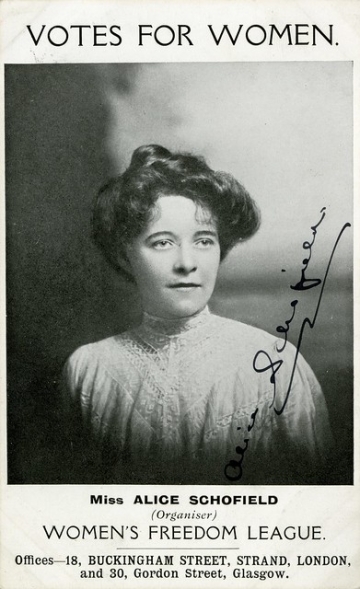Alice Schofield
The full resource is FREE to all registered users of the website
If you are not already registered you can sign up for FREE website access to download the full resource.

- Born: 1881
- Died: 1975
- Occupation: Teacher of Mathematics
- Claim to fame: Middlesbrough’s first female councillor.
Background
Alice was born in Cleveland but her parents were poor and sent her to Manchester to be brought up by her aunt and uncle. She became a mathematics teacher and, while supporting a friend who was being disciplined for refusing to teach religious studies, she met Emmeline Pankhurst. She joined the Women’s Social and Political Union (WSPU) in 1903.
Political activism
Alice was a member of the Labour Party and committed to democratic ideals. She left the WSPU, along with Charlotte Despard and Teresa Billington-Greig, to form the new Women’s Freedom League (WFL) in 1907. In 1909, Alice was arrested and sentenced to one month in prison after taking part in a deputation to the House of Commons for ‘obstructing the police’. Afterwards, she became an organiser for the WFL in Middlesbrough, where her work saw the society thrive.
The following year, in 1910, she married Charles Coates, a coal exporter, after he rescued her from a physical attack at an open-air suffrage meeting. She became Alice Schofield-Coates and the couple had three children.
Alice travelled around the country to encourage support for the WFL and the women’s suffrage cause. She remained an active member of the WFL throughout the First World War and afterwards, when the WFL fought for wider women’s rights all the way through to the 1960s. Alice became vice president of the WFL in the 1930s.
In 1919, after the changes to women’s rights, she became the first woman councillor for Middlesbrough, where she worked to improve education, working and living conditions for local people.
Alice continued trying to better the lives and rights of women locally and nationally throughout her life. She was especially passionate about the issue of women’s working conditions and equal pay, and was actively distributing leaflets advocating equal pay for equal work for women in 1951, aged 69. The Equal Pay Act was finally passed in 1970, five years before she died.
Glossary
- Women’s Freedom League – This was a suffragist and women’s equality organisation that was opposed to using violent means to campaign for women.
- The Equal Pay Act – Until 1970, it was legal to openly pay women less than a man for doing the same job.
Questions
- Why were many suffragists concerned with women’s working conditions as well as their right to vote?
- What type of non-violent activities did the WFL practise to get their views noticed?
- Why does it matter that men and women have equal pay?
